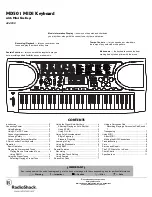
DSP Functions
Introduction to Algorithm Programming
14-3
For example, on the page below, the top line tells you that the currently selected DSP function is
the HIGH FREQUENCY STIMULATORÑits name is abbreviated and enclosed in parentheses.
You can also see that youÕre looking at F1, which in this case controls the frequency of the
HIGH FREQUENCY STIMULATOR. So the top line of these pages always shows three things:
1) the currently selected control input (PITCH or F1ÐF4); 2) the aspect of the current DSP
function controlled by the input (this varies depending on the current DSP function); 3) the
currently selected DSP function (usually abbreviated, and in parentheses). Items 1) and 2)
match the label of the soft buttons that select each page. The page below, for example, is
selected with the soft button labeled ÒF1 FRQ.Ó
EditProg:F1|FRQ(HIFRQ|STIM)<>LAYER:1/1||
Coarse:
C|4|262HZ|||
|Src1||:OFF||||||||||
Fine||:0ct||||||||||Depth|:0ct||||||||||
||||||||||||||||||||Src2||:OFF||||||||||
KeyTrk:0ct/key||||||DptCtl:OFF||||||||||
VelTrk:0ct||||||||||MinDpt:0ct||||||||||
Pad|||
:
0dB|||
|
||||||
M
axDpt:
0
ct||||
|
|||||
<more|
|
F1|FRQ
|
F2|DRV
|
F3|AMP
|
F4|AMP
|
more>
Additional Parameters
In addition to the common DSP control parameters youÕll Þnd on each page, youÕll also see a
few others on various pages. TheyÕre described here, since programming them is the same
regardless of the page on which they appear. Depending on the DSP function they affect, theyÕll
have different ranges of values and different units of measurement (%, dB, etc.).6
Pad
Many of the DSP functions boost the signal as it passes through. Depending on the signalÕs
input level and the amount of gain (boost) introduced by any given DSP function, its output
may clip, which will alter the sound considerably. Clipping may also occur as a result of phase
shifting, but this is not as common as clipping caused by gain. While you may Þnd clipping to
be a useful component of some sounds, youÕll want to remove it from others. The Pad
parameter, which appears on the control input pages of many DSP functions, lets you attenuate
(reduce the amplitude of) the signal by 6, 12, or 18 dB at the input of those functions. Use the
Pad parameter to reduce or eliminate any undesired clipping caused by the currently selected
DSP function.
Key Track Start (KStart)
This parameter appears on many control input pages, and gives you added control over the
effect of Key Tracking. For each note you play, it multiplies the value of the KeyTrk parameter
by a number that varies with the noteÕs MIDI key number. If KeyTrk is set to 0, this parameter
will have no effect. When KeyTrk is a non-zero value, KStart will modify the normal key
tracking curve, which is shown is the diagram below. The effect of normal key tracking reaches
its minimum at C -1, and its maximum at C 9. You can use KStart to dampen the effects of key
tracking at one end of the keyboard. If key tracking causes a sound to clip or distort toward the
high end of the keyboard, for example, you can use KStart to reduce the effect of the key
tracking at the upper end without changing its effect on the lower end. To do this you would
set a negative value for KeyTrk, and a unipolar value for KStart.
Normal KeyTrk curve
(Positive KeyTrk value)
C 4
C 3
C 5
Summary of Contents for K2500RS
Page 12: ...Table of Contents TOC 12...
Page 16: ...Introduction How to use this manual 1 4...
Page 32: ...User Interface Basics The Panel Play Feature K2vxR 3 8...
Page 106: ...Effects Mode and the Effects Editor Configurations and Parameters 9 24...
Page 186: ...Song Mode Recording Multi timbral Sequences via MIDI 12 52...
Page 304: ...DSP Functions Hard Sync Functions 14 52...
Page 394: ...Programs Setups and Keymaps K2500 ROM Keymaps 21 12...
Page 402: ...LFOs LFO Shapes 23 4...
Page 406: ...Note Numbers and Intonation Tables List and Description of Intonation Tables 24 4...
Page 434: ...DSP Algorithms 26 14...
Page 450: ...MIDI and SCSI Sample Dumps SMDI Sample Transfers 29 8...
Page 464: ...Glossary 31 6...
Page 490: ...K2vx Program Farm VOX K25 Appendix A 22...
Page 494: ...K2vx Compatibility Converting programs from the K2vx to K2000 Appendix B 4...
















































